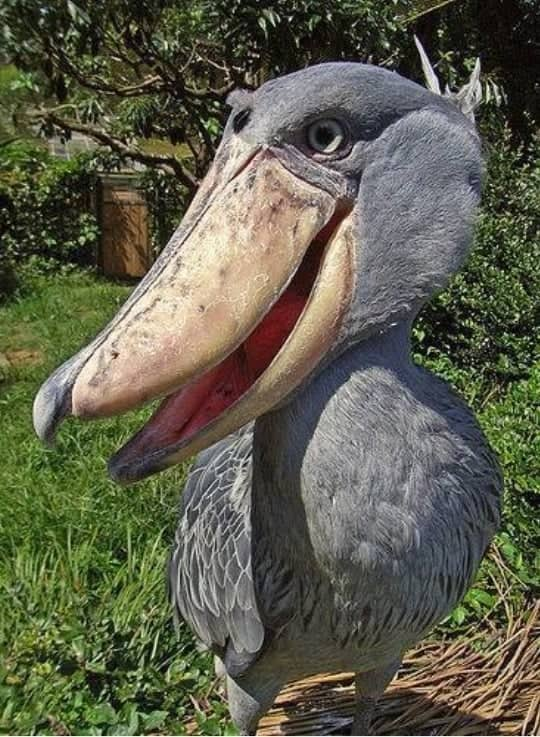The shoebill (Balaeniceps rex) is a huge storklike bird. This bird is also called as whalehead, whaleheaded stork, and shoebilled stork. It has a huge shoe-shaped bill, as the name says. Based on this morphology, it was previously classified with the storks in the order of Ciconiiformes, but genetic evidence places it with the Pelecaniformes. The color of the adult one is mainly grey, and the juveniles are browner. These birds live in tropical east Africa in extensive swamps from South Sudan to Zambia.
Their primary food is large fishes like lungfish, eels, and catfish. They also eat some crazy things as well like Nile monitor lizards, snakes, and baby crocodiles.
Taxonomy and systematics Ancient Egyptians knew the shoebill before, but the bird was not classified until the 19th century. It was classified after skins, and eventually, live specimens were brought to Europe. In 1850, John Gould gave it the name Balaeniceps rex. The genus name come from the Latin word Balaena, “whale,” and caput, “head,” abbreviated to ceps in compound words.

It has a goofy charm look; sometimes, it also looks like it might go on the attack at any moment.

Its foot-long bill makes his name. Five inches wide and has sharp edge and a sharp hook on the end.

The huge bill allows it to eat large animals like lungfish, tilapia, eels, snakes, baby crocodiles, and Nile monitor lizards.

Shoebill is up to five feet tall with an eight-foot wingspan and has yellow eyes, gray feathers, white bellies, and a small feathered crest on their heads.

Their legs are long, thin and they have large feet ideal for walking on the vegetation in the freshwater marshes and swamps. They live in East Africa, from Ethiopia and South Sudan to Zambia.

Genetic research has re-classified them as members of Pelecaniformes and the family Balaenicipitidae, previously classified as storks. Balaenicipitidaes are large waterbirds, genetically closer to pelicans and herons.

Apart from large prey, the shoebill also eats frogs, lizards, watersnakes, snails, and rodents.

It can stand in the shallows of swamps and on aquatic vegetation while hunting for food because it is extremely tall. The average height is between 3.5 – 4.5 feet, and weight is 9 – 15.5 (1 – 1.4 meters) pounds (4 – 7 kg). The average wingspan is between 7.5 – 8.5 feet (2.2 – 2.6m)

Their population is difficult to evaluate accurately because of their habitat and elusive nature, but it has declined – with estimates between 5,000 – 8,000 in total.

Due to habitat destruction, disturbance, and hunting, BirdLife International has classified it as vulnerable. They have specific habitat requirements for breeding, nesting, and hunting, and their swamps and marshes are gradually being transformed into agricultural land or pastures for cattle grazing.

Their appearance is unusual; they seem like a dinosaur. Sometimes when we look at them from different angles, they can appear rather menacing, peering down their long, razor-sharp beak with a hook at the tip.

Sometimes they look cute like characters in cartoons, and their striking pale and blue-eyed genes make them look like they are not real.

Shoebill is one of the slowest flapping birds while flying at a mere (approx.) 150 flaps per minute.

Shoebill has the 3rd most extended beak in the world, reaching up to 24cm in length and 20cm (7.4 to 9.4 inches) in width.

The edge of the beak is razor sharp, allowing them to decapitate their prey quickly. They are known to often behead their prey before consuming it whole.





The presence of hippos can sometimes benefit shoebills because they disturb fish and bulldoze paths through swamps. So, the shoebill takes advantage of the water’s disturbed fish and strikes.
Could you go and check my other article also?











I so very much love a ShoeBill their just a beautiful creature… one minute a serious look next a look of a giggle.. I hope we can save thee habitat it’s unfair..We must come together to save our whole planet!! 🫵🏼🪨✌🏼💗😊
It is remarkable, very much the helpful information
Car Hire Athens
Bravo, what necessary phrase…, a magnificent idea
cialis dapoxetine
levitra buy line
free coupons for levitra
generic levitra cost
tadalafil online pharmacy
vardenafil (levitra)
tadalafil pde 5
levitra dosage
levitra sales online
cialis 100 mg usa
sildenafil uses
tadalafil or sildenafil which is better
veterans online pharmacy
dragon pharmacy phentermine
northwest pharmacy domperidone
sildenafil generic viagra
tesco artane pharmacy